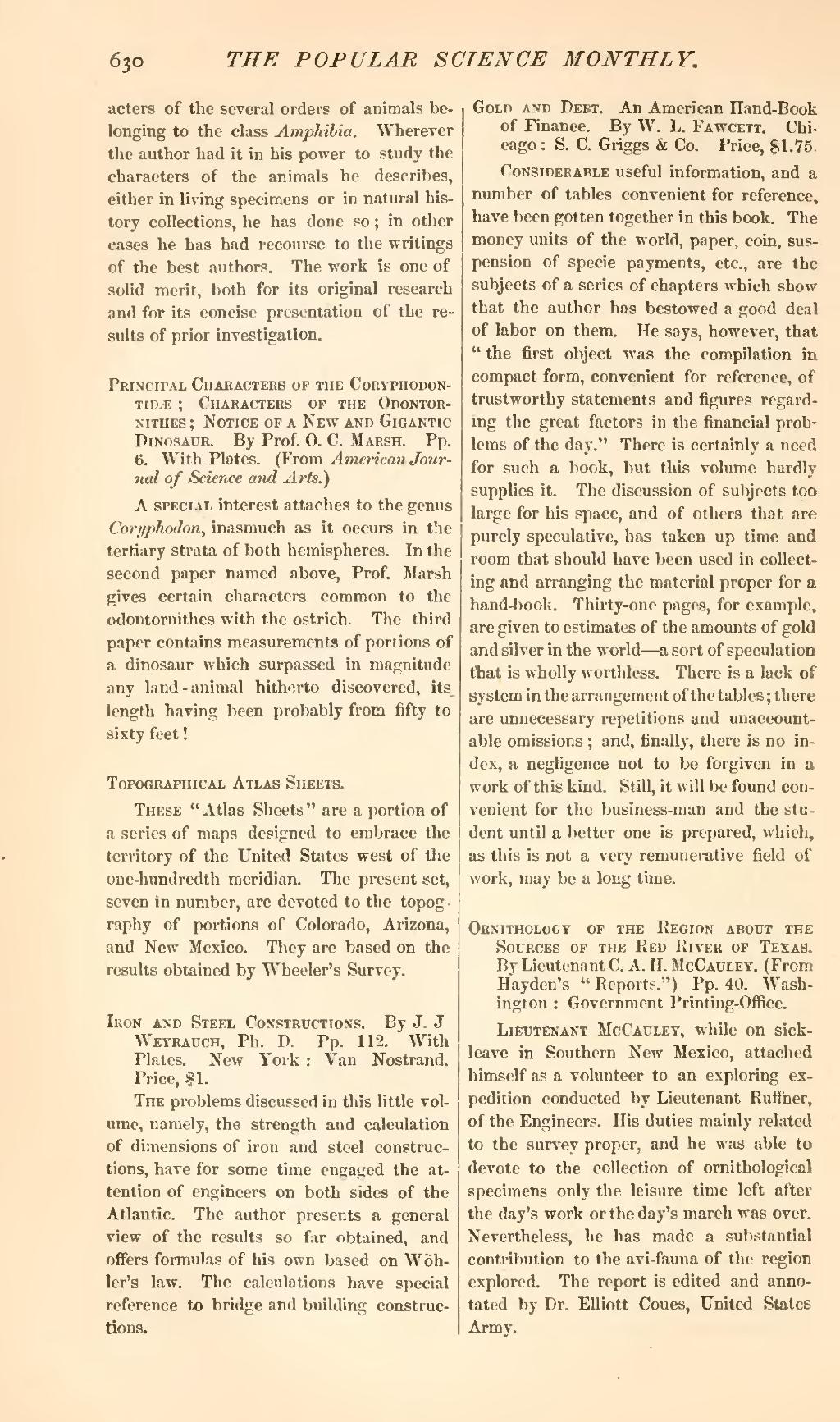acters of the several orders of animals belonging to the class Amphibia. Wherever the author had it in his power to study the characters of the animals he describes, either in living specimens or in natural history collections, he has done so; in other cases he has had recourse to the writings of the best authors. The work is one of solid merit, both for its original research and for its concise presentation of the results of prior investigation.
Principal Characters of the Coryphodontidiæ; Characters of the Odontornithes; Notice of a New and Gigantic Dinosaur. By Prof. O. C. Marsh. Pp. 6. With Plates. (From American Journal of Science and Arts.)
A special interest attaches to the genus Coryphodon, inasmuch as it occurs in the tertiary strata of both hemispheres. In the second paper named above, Prof. Marsh gives certain characters common to the odontornithes with the ostrich. The third paper contains measurements of portions of a dinosaur which surpassed in magnitude any land-animal hitherto discovered, its length having been probably from fifty to sixty feet!
Topographical Atlas Sheets.
These "Atlas Sheets" are a portion of a series of maps designed to embrace the territory of the United States west of the one-hundredth meridian. The present set, seven in number, are devoted to the topography of portions of Colorado, Arizona, and New Mexico. They are based on the results obtained by Wheeler's Survey.
Iron and Steel Constructions. By J. J Weyrauch, Ph. D. Pp. 112, With Plates. New York: Van Nostrand. Price, $1.
The problems discussed in this little volume, namely, the strength and calculation of dimensions of iron and steel constructions, have for some time engaged the attention of engineers on both sides of the Atlantic. The author presents a general view of the results so far obtained, and offers formulas of his own based on Wohler's law. The calculations have special reference to bridge and building constructions.
Gold and Debt. An American Hand-Book of Finance. By W. L. Fawcett. Chicago: S. C. Griggs & Co. Price, $1.75.
Considerable useful information, and a number of tables convenient for reference, have been gotten together in this book. The money units of the world, paper, coin, suspension of specie payments, etc., are the subjects of a series of chapters which show that the author has bestowed a good deal of labor on them. He says, however, that "the first object was the compilation in compact form, convenient for reference, of trustworthy statements and figures regarding the great factors in the financial problems of the day." There is certainly a need for such a book, but this volume hardly supplies it. The discussion of subjects too large for his space, and of others that are purely speculative, has taken up time and room that should have been used in collecting and arranging the material proper for a hand-book. Thirty-one pages, for example, are given to estimates of the amounts of gold and silver in the world—a sort of speculation that is wholly worthless. There is a lack of system in the arrangement of the tables; there are unnecessary repetitions and unaccountable omissions; and, finally, there is no index, a negligence not to be forgiven in a work of this kind. Still, it will be found convenient for the business-man and the student until a better one is prepared, which, as this is not a very remunerative field of work, may be a long time.
Ornithology of the Region about the Sources of the Red River of Texas. By Lieutenant C. A. H. McCauley. (From Hayden's "Reports.") Pp. 40. Washington: Government Printing-Office.
Lieutenant McCauley, while on sick leave in Southern New Mexico, attached himself as a volunteer to an exploring expedition conducted by Lieutenant Ruffner, of the Engineers. His duties mainly related to the survey proper, and he was able to devote to the collection of ornithological specimens only the leisure time left after the day's work or the day's march was over. Nevertheless, he has made a substantial contribution to the avi-fauna of the region explored. The report is edited and annotated by Dr. Elliott Coues, United States Army.
